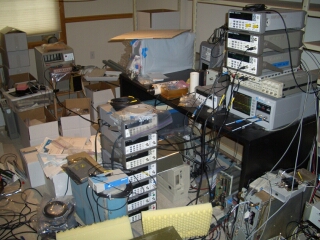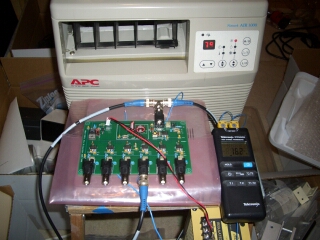 |
 |
01-Dec-2005
There are many design specifications for a multi-port RF distribution amplifier: drive level, DC power requirements, gain, isolation, frequency response, insertion delay, channel skew, drift, and temperature stability.
For precision timekeeping applications isolation and phase stability are among the most important specifications. The following are the results of temperature tests I ran on two versions of the TADD-1 distribution amplifier.
In summary, the TADD-1 channel-channel skew tempco is less than 1 ps / °C and the input-output tempco is on the order of 150 ps / °C, a value that is probably sufficient for amateur timekeeping use.
It is, however an order of magnitude greater than the original TADD-1 prototype. The input bandpass filter or the output isolation transformers (not present in the prototype) probably contribute to the larger tempco.
By placing the distribution amplifier directly in front of the high-speed air flow of the A/C the board is exposed to either cool air (when the compressor is on) on the order of 12 to 13 °C or to ambient air (when the compressor is off) on the order of 25 to 26 °C. So the temperature swing in all the tests below is about 13 °C. The A/C cycles once about every 6 to 8 minutes.
The input to the distribution amplifier was a 10 MHz reference signal from a HP 58503B GPS Time & Frequency receiver. For channel-to-channel measurements two outputs of the distribution amplifier were compared against each other with a TSC 5110A Time Interval Analyzer.
For insertion delay measurements a BNC or SMA Tee was used at the distribution amplifier input and one of the outputs was compared with this copy of the input. Since all measurements are differential the accuracy or quality of the 10 MHz reference signal was not a factor.
The temperature coefficient was determined by measuring the amplitude of the phase cycles resulting from the A/C temperature cycles.
In the plots below the insertion delay is about 70 ns.
The phase varies by about 2.0 ns over 13 °C giving a tempco of about 150 ps / °C.
Phase variations due to 13 °C swing (A/C compressor cycling every 6 to 8 minutes).
Raw phase and zero normalized phase
Frequency excursions due to rapid temperature change. The unusual Allan Deviation shows effect of A/C thermal cycles.
Frequency and Allan Deviation
In the plots below the insertion delay is about 1 ns. See Making Accurate Sub-Nanosecond Phase Measurements where the delay is precisely measured as 607 ps.
The phase varies by about 135 ps over 13 °C giving a tempco of about 10 ps / °C.
Phase variations due to 13 °C swing (A/C compressor cycling every 6 to 8 minutes).
Raw phase and zero normalized phase
Frequency excursions due to rapid temperature change. The unusual Allan Deviation shows effect of A/C thermal cycles.
Frequency and Allan Deviation
In the plots below the insertion delay is about 70 ns.
The phase varies by about 500 ps over 13 °C giving a tempco of about 40 ps / °C.
Phase variations due to 13 °C swing (A/C compressor cycling every 6 to 8 minutes).
Raw phase and zero normalized phase
Frequency excursions due to rapid temperature change. The unusual Allan Deviation shows effect of A/C thermal cycles.
Frequency and Allan Deviation
Just how much of the tempco measured above is due to the connectors, the cables, and the TSC 5110A Time Interval Analyzer? To discover this the distribution amplifier was replaced with just a SMA tee. This is probably not proper etiquette for impedance or reflections, but you can't get much simpler than a 1 cm connector.
In the plots below the insertion delay is about 226 ps. This is cable length and TSC 5110A input channel mismatch and could be subtracted from any of the above measurements if it were significant
The phase varies by about 0.5 ps over 13 °C giving a tempco of less than 50 fs / °C. This implies the test fixture itself does not contribute to the measured tempco above.
Phase variations due to 13 °C swing (A/C compressor cycling every 6 to 8 minutes).
Raw phase and zero normalized phase
Frequency excursions due to rapid temperature change. The Allan Deviation is nearly flat with -1 slope.
Frequency and Allan Deviation
It would be expected that the metal case of the FS710 would help insulate the PCB inside from quick thermal changes. To check this the same test was run on an assembled FS710/
In the plots below the insertion delay is about 70 ns.
The phase varies by about 80 ps over 13 °C giving a tempco of about 6 ps / °C.
Phase variations due to 13 °C swing (A/C compressor cycling every 6 to 8 minutes).
Raw phase and zero normalized phase
Frequency excursions due to rapid temperature change. The unusual Allan Deviation shows effect of A/C thermal cycles.
Frequency and Allan Deviation
An in-room air conditioner (A/C) with compressor cycling on/off several times per hour provides an ideal environment for measuring the temperature dependence of an RF distribution amplifier. Below is a summary of the results.
| Distribution Amplifier | Insertion Delay (ns) | Tempco (ps / °C) |
| TADD-1 PCB Kit | 70 | 150 |
| TADD-1 PCB Prototype | 0.6 | 10 |
| Stanford FS710 (PCB) | 70 | 40 |
| FS710 (enclosed) | 70 | 6 |
| SMA tee (baseline test) | 0.2 | 0.050 |
The final TADD-1 kit has a significantly higher tempco than the first TADD-1 prototype. This is almost certainly due to the input filter or the output isolation transformers. Some quick tests can be done to determine which. However, the tempco is still quite good and adequate for amateur atomic clock use.